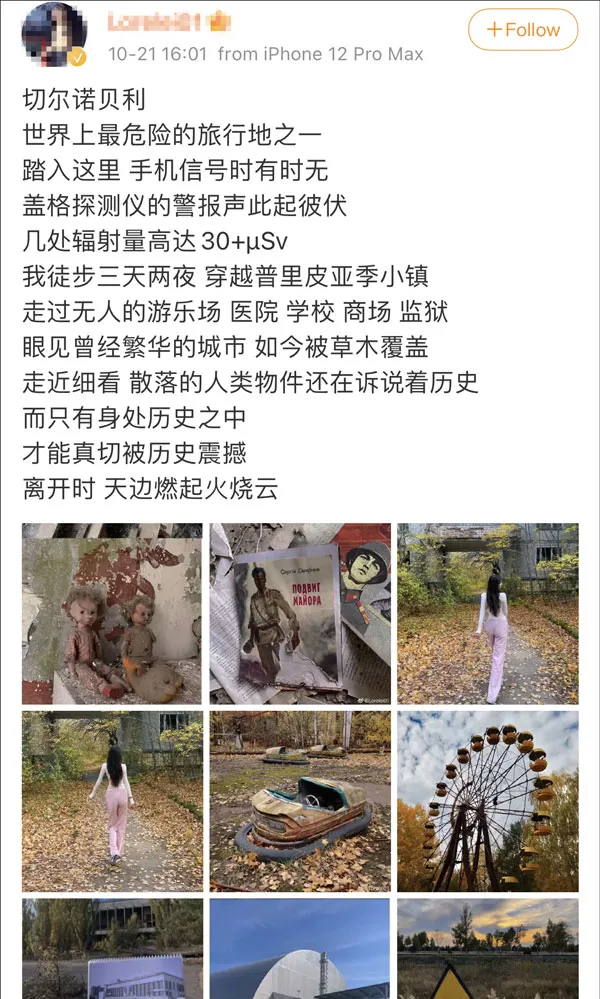October 21
A blogger with 90,000 followers
Post a group photo of The Punch Kachernobyl on Weibo
Call yourself a three-day, two-night hike
After stepping into Chernobyl, the mobile phone signal was intermittent
"The alarm of the Geiger detector rises and falls,
Radiation in several locations up to 30+ μSv (microsyv). ”

In the photo
The blogger is wearing civilian clothes
Take photos in front of several abandoned buildings
Including the famous nuclear "sarcophagus"
The act then sparked heated discussion
Some netizens questioned this move
Think they should wear protective clothing
Some netizens reminded them that they should not promote such places
May cause misunderstandings to others
Attract more people to go unprotected
The blogger replied
Wear protective clothing yourself most of the time
I will look for places with low radiation values and wear civilian clothes to take pictures
Before going in
There are protocols that tell you how to dress and what you need to bring
But
Some netizens also said
Photos taken by bloggers
Increased his knowledge of Chernobyl
On April 26, 1986, the world's worst nuclear accident occurred at the Chernobyl nuclear power plant in northern Ukraine, 140 km from Kiev, and was the first major accident to be rated as a level 7 event by the International Nuclear Incident Classification Scale (the second was the Fukushima Daiichi nuclear power plant accident in Fukushima Prefecture, Japan, on March 11, 2011). The city of Pripyat was thus abandoned. Unit 4 of the power station where the explosion occurred was completely destroyed and later sealed with cement, called "sarcophagus".
After the explosion, the Soviet government at the time, centered on reactor No. 4, designated most of the area within a 30-kilometer radius as a restricted area, evacuated the residents, and surrounded it with barbed wire.
According to the Ministry of Health of Ukraine, more than 2.39 million people fell ill as a result of the accident after the accident, of which more than 450,000 were children.
But from 2011, according to the decision of the Ukrainian government, the accident area of the Chernobyl nuclear power plant was open to ordinary tourists.
According to a 2019 report by China Youth Daily, local travel agencies in Ukraine have launched Chernobyl one-day or two-day tour packages, and only adults can sign up for the tour. Visitors are required to sign a statement promising to wear long clothes and trousers, not to touch any objects in the quarantine area, and not to have any contact with the ground, grass, or buildings.
Some visitors will spend $10 to buy a counter and test the radiation value at any time. The closer you get to the core of the quarantine zone, the larger the value of the counter. In individual locations, the value can swell to a few hundred micro-Seawaters per hour.
In 2019, when the American drama "Chernobyl" was popular, it attracted many people to punch the clock. Reuters reported in June 2019 that after the show aired in May 2019, bookings from a local travel agency in Ukraine increased by 40 percent since May.
On June 7, 2019, local time, in Pripyat, Ukraine, tourists clocked in in front of the remains of the Chernobyl nuclear power plant accident. (Source: Oriental IC)
Video blogger Jerry Guo posted a video of a Chernobyl tour in August 2019, where he was filmed in front of a "sarcophagus" in civilian clothes. At the time of shooting, according to the Geiger counter in his hand, the radiation at the site was measured at that time to be 1.04 microsieverts / hour, and the radiation of the land was 1.1 microsieverts / hour (1000 microsieverts = 1 mSievert, calculated as 8760 hours a year, 1 microsieverts / hour = 8.76 mSv / year).
In places with high radiation, including the Ferris wheel where Internet celebrities punch cards, protective clothing is required, and when Guo Jerry was filmed in 2019, the radiation at the bottom of the Ferris wheel cockpit was 125 micro-Seawart / hour.
According to Xinhua News Agency, the Chinese Center for Disease Control said that a small amount of radiation exposure will not endanger human health, and excessive radiation radiation will cause harm to the human body, causing people to become sick and deadly. The higher the dose, the greater the harm.
The data shows that humans live in a variety of radiation at every moment, and the annual effective dose of individuals from natural radiation is about 2.4 mSv globally. When the radiation dose is less than 100 mSv, the medically observed definitive effect on the human body, that is, significant tissue damage; when the dose exceeds 4000 mSv, there is a 50% mortality rate without medical supervision, and when the dose exceeds 6000 mSv, it can be fatal.
Source: Observer Network
Edit: Shi Yu